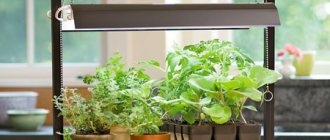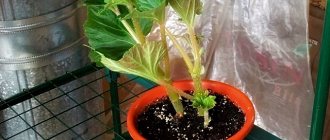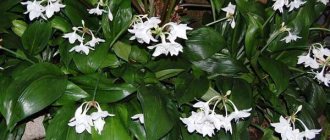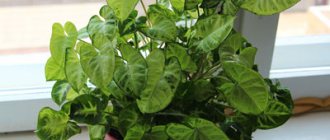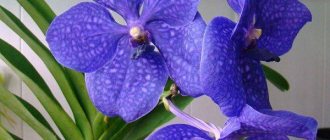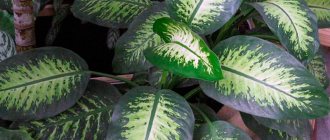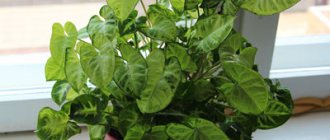How to choose a phytolamp for plants. 3 types of LED lamps - bicolor, multispectrum and full color. TABLE on the Top 15 lamps, compiled according to reviews of phytolamps (LED lamps for plants). + Self-test
TEST:
To test your knowledge of how to choose and install an LED phytolamp, take the test.
- What colors do plants need most?
a.Red and blue.
b.Green.
- How far away from the tops of plants should lamps be placed?
a.As close as possible.
b. At a height of 25-40 centimeters.
- How is the power of lamps selected?
a.50W/m²
b. Depends on growing conditions - from 40 to 150 W/m².
- What is the supply voltage for LED phytolamps?
a.220 volts.
b. In devices with a built-in power supply ~ 220V, and with an external = 12V.
Right answers:
- a – the maximum sensitivity of plants is located in the red and blue regions, and they reflect green, so the leaves are green;
- b – average distance from plants 25-40 centimeters;
- b – different plants in different conditions need different amounts of light;
- b - it depends on the design of the lamp - in devices with a built-in power supply ~ 220V, and with an external = 12V.
Test results:
- a, b, a, b - your knowledge is enough to independently select, install and connect LED phytolights;
- b, a, b, a - you do not have the knowledge to work independently;
- other options - you have knowledge, but it needs to be deepened by studying additional materials.
Plants need light to grow and develop. The best light is sunlight, but if it is not enough, then phytolamps are used. The best ones are LED. The best way to choose such lamps is to first study reviews of different models of such devices.
Phytolamps
Table: description of characteristics
JazzWay PPG A60 AGRO 9W E27 Frost 5002395
JazzWay PPG A60
JazzWay PPG A60 AGRO 9W E27 Frost 5002395 Pear-shaped model for the E27 base, made of frosted glass. In the work it gives the ratio of the spectrum of red and blue colors as 5 to 1 (650 and 450 nm, respectively) . The surface illumination area depends on the height of the lamp above the plants: from 84 to 230 cm.
Installed at a height of 20 to 50 cm above the upper leaves of plants or seedlings. Within the operating temperature limits of -10 to +40 degrees, the lamp can last up to 20 thousand light hours. The radiation angle is 120 degrees, while the photosynthetic flux is 10 µmol/s.
PROS:
- inexpensive
- compact
- universal bicolor
MINUSES:
- low-power
- polycarbonate body
- short service life
NAVIGATOR 61 202 NLL-FITO-A60-10-230-E27
NAVIGATOR 61 202 NLL-FITO-A60-10-230-E27
NAVIGATOR 61 202 NLL-FITO-A60-10-230-E27 Low-power base (10 W) model produces a photosynthetic flux of 19 µmol/with an angle of 270 degrees. A universal bicolor (red/blue) phytolamp will last 40 thousand light hours.
The glass bulb is frosted, the parameters of the pear-shaped apparatus are 11.2 cm by 6 cm, with a weight of only 120 g. The device operates properly at air temperatures from -10 to +40 degrees.
PROS:
- energy saving model
- affordable price
- wide beam angle
MINUSES:
- low efficiency
- low degree of protection against dust and splashing water (IP 20)
- only for plinth
Kreonix T8
Linear lamp Kreonix T8
Kreonix T8 Linear phytolamp with a matte bulb 90 cm long consumes 15 W, which corresponds to the power of 30 W of its fluorescent counterpart. The radiation angle in the Kreonix T8 model is 120 degrees, service life is 50 thousand light hours.
The color spectrum is blue (wavelength 450 nm) and red (wavelength 660 nm), the shade of white is pink.
PROS:
- Suitable for lighting aquariums
- compact
MINUSES:
- exclusively for base G13 (T8)
- not protected from splashing water
Camelion Phyto LED15-PL/BIO 15 W E27
Camelion Phyto 15 W
Camelion Phyto LED15-PL/BIO 15 W E27 Compensating for the lack of sunlight for house plants, the Camelion Phyto lamp is also suitable for seedlings, creating optimal conditions for growth, ovary and fruiting. The lamp has a power consumption of 15 W, suitable only for the e27 base, with a bicolor emission spectrum: blue (23%) and red (77%).
The lamp is placed at a distance of 15 to 100 cm from the plants, forming a light beam angle of up to 120 degrees. Allowed to be used at temperatures from -30 to +40 degrees, with a service life of more than 30 thousand light hours.
The photosynthetic photon flux of the model is 25 µmol/s, the diameter of the illumination circle when suspended at a height of 50 cm is 174 cm.
PROS:
- universal, compact
- does not contain mercury
- low power consumption
- low ripple factor (10%)
- compact (13.8x8 cm)
MINUSES:
- Suitable for E27 socket only
Lyra "NPO FITOVATT"
Option for mounting a lamp for plants "Lyra" above the windowsill
Lyra "NPO FITOVATT" A Russian-made phytolamp, which differs from analogues in its original suction cup mount. It looks like an LED strip and provides an illumination of 2700 Lux. The length of the device varies from 20 cm (2.4 W) to 200 cm (24 W), height and width - 1.2 cm each.
From individual lamp blocks you can create clusters to illuminate a greenhouse, winter garden, or greenhouse. Bicolor LEDs - red and blue colors - are optimal for enhancing the growth and development of plants and seedlings. The lamp gives bright light, but does not burn the leaves.
PROS:
- power supply included
- easy to move
- Mounts even on glass, horizontally and vertically
- can be combined with other phytolamps
MINUSES:
- very narrow – gives a small strip of light
- Needs mounting space, can't be hung
GR14 655mm
Schematic representation of the GR14 655mm model on aluminum hangers
GR14 655mm The device in an aluminum case on a cable suspension combines 420 LEDs with red (210) and white (210) glow. Pink color is easily perceived by human vision and has a beneficial effect on plant development. The lighting angle guaranteed by the device is 120 degrees.
The power of the phytolamp is 25 W. The length of the model is 65.5 cm with a width of 75 mm, the device weighs only 0.5 kg.
PROS:
- small-sized, lightweight lamp
- reliable fastening system
- the case does not heat up
- no noise during operation
- It is possible to connect LEDs in a continuous circuit
MINUSES:
- low power of the device with a large number of LEDs
- cannot be placed on a windowsill, only hung
- used only in dry rooms
Health Treasure Growing 16 W
The principle of operation of a “growing” lamp
Health Treasure Growing 16 W A model that is used both as the main light source and for additional illumination of indoor plants. Characterized by low energy consumption (16 W) with a powerful photon flux of 24.5 µmol/s. The device, due to 48 diodes, produces full-spectrum light with a creamy glow that is pleasant to the human eye.
Positioned as a “growing” lamp for plants due to the height adjustment of the device. The working part rotates along an axis, making it possible to illuminate seedlings or plants at an angle. High efficiency is achieved with continuous operation for 8-14 hours.
In complete darkness it is capable of illuminating up to 50 cm2 of surface area. Works optimally at air humidity of 85%, temperature from 0 to 45 degrees. The model parameters are 56x56x22 cm, the body is made of a combination of steel and plastic.
PROS:
- ease of assembly and use
- the switch is located on the body
- The kit includes a support stand and a limiter
- each LED module operates for more than 30 thousand hours
- II class of protection against electric shock
MINUSES:
- no protection against splashing water
- the case heats up quickly
Perseus "NPO FITOVATT"
Linear configuration of the Perseus plant lamp from NPO FITOVATT
Perseus "NPO FITOVATT" Lamp for plants with LEDs, "Perseus" is used for additional illumination of indoor plants in conditions of lack of sunlight. When growing seedlings, it is optimal for cucumbers, vegetables, and onions.
The device is placed on window sills up to 1.4 m long using a fastening system. The lamp has compact dimensions of 3x3 cm, and the length is adjustable from 0.4 to 2 m . The body is made of aluminum, so it does not heat up during operation.
The total performance of 8 LEDs of the Perseus phytolamp is 24 W (3 W for each). Full-spectrum illumination options are available, as well as with the addition of bicolor and white light. Provides illumination of 3500 Lux.
PROS:
- low power consumption
- helps accelerate growth, vegetation, fruiting of seedlings
- doesn't make noise
MINUSES:
- unreliable fastening system
- only for placement on windows
Flora Lamps E27 120w
Base model Flora Lamps E27 120w
Flora Lamps E27 120w A full-spectrum device for additional illumination of indoor, flowering or fruit-bearing plants, also used to increase yields and accelerate the ripening of seedlings. Made of plastic and weighing only 255 g, it consists of 36 high-performance LEDs (22 red, 8 blue, 1 white, 2UV, 2IR, 1 warm).
The lamp produces full spectrum light at an angle of 120 degrees. Placed at a height of 100-120 cm above the level of the upper edge of the foliage. The device remains operational at temperatures from -20 to +40 degrees, and the body does not overheat.
The Flora Lamps E27 120w model features a ventilation system that extends the life of LEDs while maintaining their high performance. The lamp power is 120 W, with a power consumption of only 30 W.
PROS:
- service life - more than 50 thousand hours
- compact dimensions (14x12 cm)
- bright light
- high-quality assembly
- silent cooling
MINUSES:
- Suitable for E27 socket only
- ineffective for plants on the windowsill due to spot lighting
- high price
Garden Show Phytopanel Optimum 14 W
The wide dimensions of the Optimum phytopanel from Garden Show provide a large field of light
Garden Show Phytopanel Optimum 14 W Phytolamp in the form of a panel with 225 bright LEDs in red (84), orange (76), blue (41) and white (24) colors. The device is placed even at a minimum distance (200 mm) from indoor plants and seedlings, since the light does not cause burns on the leaves. Lighting promotes growth, strengthening, stimulation of flowering, seed germination and fruiting.
The dimensions of the device, made of plastic and metal, are 31x31x3.4 cm, weight - 1.4 kg. The set includes a hook for hanging the phytolamp above a horizontal surface. Does not produce stray ultraviolet radiation, the housing does not heat up during operation.
PROS:
- economical and compact
- doesn't make noise
- can be moved
- many LEDs – large coverage area
- the color spectrum is close to that usual for human optical perception
- Suitable for supplementary lighting of plants and for growing seedlings
MINUSES:
- high price
- no stand
- cannot be combined with other types of additional lighting
Lamps accelerate photosynthesis processes in plant leaves, promoting growth and development
When choosing a reliable, high-quality phytolamp, one proceeds from the goals that need to be achieved. For growing seedlings, a home greenhouse or a winter garden, powerful models with full or multispectrum LEDs, a wide beam angle and bright light are suitable.
For artificial supplementary lighting, the indicators of photosynthetic flow and illumination level are important - the higher they are, the faster the growth and development of plants occurs due to the processes of photosynthesis.
For several pots with indoor plants, a low-power narrow beam with a radiation spectrum - universal bicolor (red and blue) is sufficient. A balanced solution is an LED light bulb with an E27 base, which is screwed into a stationary base from a regular table lamp.
Illumination of seedlings - LED phytolamps for plants. Review. Which one to choose?
TOP 10 Best phytolamps for growing seedlings and indoor plants: choosing which one is better? | Rating + Reviews
Description of 2 and multi-color LED phytolamps
A phytolight is a lamp designed to illuminate plants when there is little or no natural light. It can be monochrome, 2 or multi-color, with the addition of white and ultraviolet.
Look in the picture at the spectrum of light needed by plants. During different periods of growth, plants need light of different colors. The most commonly used are red and blue, and in more expensive models white and ultraviolet. Phytolamps provide lighting with the required spectral composition and brightness.
These lamps use LEDs of different colors as a light source. The color ratio is adjusted by reducing the brightness or turning off unnecessary light sources.
Power is supplied from a ~220V network or an external power source =12V.
If necessary, such a lamp is made from scrap materials and LEDs or LED strips of the required colors - red, 630 nM, and blue, 465 nM. These values are close to the 660 and 445 nM used in factory designs.
It is allowed to use RGB strips and LEDs without connecting the green light.
Growth graph from light spectrum
Consumer Reviews
Before purchasing LED phyto-tape, many people turn to the Internet for help, carefully re-reading the reviews of those who have similar experience in plant growing. At this stage, it is important not to be disappointed in the new technique and to draw the right conclusion based on the opinions of people who have achieved success. To do this, you may have to participate in thematic forums and correspondence. An in-depth study of the issue of organizing lighting based on LED strip will allow you to avoid the mistakes listed above, which then lead to negative reviews.
Every plant grower must understand that even a slight deviation from generally accepted conditions for growing plants can have a bad effect on their development. Incorrectly organized LED lighting is no exception. Therefore, simply exposing flowers to blue and red light is not enough. At a minimum, it is necessary to control the distance from the lamp to the leaves, observe the day and night regime, and be confident in the quality of the phyto-tape used. Only a serious approach to business guarantees positive feedback in the future.
The whole truth about LED phytolamps - 3 advantages and 1 disadvantage
LED phytolamps have advantages over other types of lamps:
- LEDs emit light, but, unlike other types of lamps, they do not heat up and do not warm the plants located under them;
- arranged evenly above the pots or collected in panels, which prevents the flowers from tilting towards the light;
- This is the most economical and durable light source.
The only drawback is the higher price, but it pays off due to energy savings and is gradually decreasing.
Full Spectrum LED Plant Growth Strip
Sometimes RGB sources are called this, which is not correct, since installing full-spectrum LEDs on a strip is technologically impossible.
The USKI source is a blue spectrum LED coated with a special luminescent layer. This design allows luminous flux to be emitted in the range of 400-800 nM, with the peak intensity occurring at 630-640 nM (spectrogram shown in Figure 3).
Figure 3. Spectrogram of USKI LED
Some unscrupulous manufacturers indicate a peak intensity of 660 nM in their products; this, to put it mildly, does not correspond to reality, since the technology used does not allow obtaining a source with such a characteristic. This limitation can be circumvented when making matrices; for this purpose, I install several crystals of the red spectrum in them.
LED and LED matrix manufactured using USKI technology (proportions not respected)
The cost of this type of LED source is not much less than phyto tape, which makes it not an entirely acceptable alternative.
LED phytolamps for 2 types of aquariums – freshwater and marine
Look in the picture at the aquarium illuminated by phytolamps. There are also plants (algae) here and they are different in fresh and sea water.
In a freshwater body of water, algae require red and blue colors in a ratio of 5:1. In the sea, salt water absorbs red light, so the deeper the home of the aquarium's inhabitants, the bluer the illumination.
The inhabitants of the aquarium are better influenced by brighter light 8-10 hours a day than weak light 14-16 hours. The origin of most aquarium algae and corals is the tropics, where daylight hours last 12 hours, the period of photosynthesis is no more than 10, and long-term illumination provokes the development of lower algae.
According to the observations of Western aquarists, a decrease in illumination during the day by 1-2 hours has a positive effect on the processes occurring in plants.
The recommended average power of LED lamps is from 0.1-0.3 W/l in aquariums without algae to 0.8 W/l and higher in “Dutch” aquariums with lush vegetation.
LEDs for aquariums
How to choose the right phytolamp for seedlings and indoor plants?
Based on the type of light source, all products can be divided into several main groups - fluorescent, halogen, sodium and LED. Standard incandescent light bulbs are not used here due to their short service life and minimal efficiency. The most modern devices last a long time, are able to provide the required range, they tolerate voltage fluctuations well, and can work without interruption for quite a long time. Their brightness begins to decrease after about 2-2.5 thousand hours of operation.
Gas-discharge lamps are much more expensive than others, but they can last for 20,000 hours, and with their help it is possible to provide the plant with a spectrum that is as close as possible to natural solar radiation. LED and fluorescent ones are not capable of producing a similar effect.
When choosing a bulb for plants, be sure to check what spectrum format it creates. The cheapest ones are bicolor, where red and blue colors of the spectrum are mixed. It is unlikely that they can be used as a stand-alone light source, but they are well suited as an addition to the natural spectrum. Multispectral colors combine red, blue and warm white. They can also be used separately from natural radiation. In addition, such products are optimally suited for plants with fairly dense foliage, as well as for already blooming indoor flowers.
Phytolamps. How to place a phytolamp correctly.
Full spectrum lamps are often used in greenhouses during the winter. They can completely replace real sunlight. However, it must be taken into account that such devices are very irritating to the eyes and are intended for placement only in non-residential premises. The shape of the lamps can be linear, round, with sockets of various sizes.
When we selected products for inclusion in our rating of the best phytolamps, we took into account all the factors listed above. However, some other points were also taken into account - price-quality ratio, as well as user reviews. The review includes the most effective devices that are not too expensive, so that each of our readers can choose the most suitable model for themselves.
LED phytolamps for phalaenopsis orchids – 2 types of lighting
Look in the picture at the phalaenopsis orchids illuminated by phytolights. Lamps must provide diffuse illumination, so one lamp is not enough, regardless of power. They are installed as close to the plants as possible (3-5cm). The choice of color depends on the task facing the plant owner.
Red light stimulates active flowering. To do this, it is enough to turn on the lamps for an hour twice a day, in the morning and in the evening.
Leaves grow in blue light. They should also be turned on in the morning and evening, in the dark, to extend the daylight hours of the plants.
Blue-colored lamps that produce almost no visible light are black lamps.
The best option is a combination of red and blue colors, for the growth of flowers and leaves, and white, which turns on when there is a lack of daylight.
There are two light distribution options:
- red and blue lamps shine simultaneously;
- A red lamp shines in the morning and evening, and a blue lamp during the day.
When there is insufficient natural light, the white light is turned on twice a day for an hour.
LED phytolamps for orchids
What is special about LED strips for plants?
It has been scientifically proven that a blue LED with a violet tint, operating at a wavelength with a peak around 445 nm, is responsible for effective leaf growth. And for the development of fruits, red light of a velvety hue with a maximum intensity of about 660 nm is needed. There is nothing wrong with the fact that the spectral characteristic of the phytodiode is somewhat blurry (±20 nm), but the peak of the radiation should fall exactly at the specified wavelength. That is why ordinary red and blue tapes, emitting 630 nm and 470 nm, respectively, are not suitable for illumination.
LED phyto-tape should be used as a source of additional light for plants grown on a windowsill, loggia, or greenhouse. These are mainly places where sunlight with a full spectrum of radiation is present, but in small quantities. The purpose of the illumination is to increase daylight hours to 18 hours, thereby accelerating the growth, flowering and ripening of fruits. If we are talking about plants that are located in the part of the room farthest from the window, then only blue and red LEDs will not be enough. In this case, multispectral lamps should be used, the light of which is most similar to the rays of the sun.
Do-it-yourself phytolamp for plants - 4 stages of assembly
Look at the picture at the homemade phytolamp. If necessary, it is made by hand. Such a product will not be as beautiful as a factory-made one, but it will be much cheaper, and it will help plants grow almost as well.
For manufacturing you will need the following materials:
- LEDs. In such designs, special LEDs are used for phytolamps or super-bright ones installed on the radiator. Instead, you can use a large number of low-power tapes of appropriate colors (630 and 465 nM) or RGB tapes.
- Base or radiator. When using aluminum or steel strip, these elements are combined.
- Power supply. This is a special driver, dimmable power supplies for each color or one unit and switches for groups of LEDs. The power should correspond to the power of the lamps and 20% reserve.
- Base. It uses a plastic box or a metal structure that can serve as a radiator. The size should match the length of the bed and not blind people on the street.
- Stand for fastening. It is advisable to provide height adjustment. Instead of a stand, it is allowed to hang the phyto-lamp from the ceiling.
- Installation wires. Copper strands are used, which are soldered to the LEDs.
The assembly order is as follows:
- Check elements for serviceability. The LEDs are checked by a tester, and the tape is checked by applying voltage.
- Attach light sources to the base. High-brightness LEDs are attached with bolts and thermal paste, and the tape is secured with an adhesive layer or double-sided tape.
- Connect the wires using soldering or connectors.
- Attach the base to the stand and adjust the height.
Do-it-yourself phytolamp for plants
LED phytolamp with g13 socket
Lamps designed for the use of fluorescent lamps with a standard G13 base are used as homemade phytolights. In such devices, instead of conventional ones, with minimal modification of the circuit, LED lamps, white or colored, of the same dimensions and shape are installed.
LED phytolamp with g13 socket
How to choose a phytolamp
The optimal values for plants are wavelengths in the blue spectrum of 420-460 nm and in the red spectrum of 630-670 nm. The spectrogram on the lamp packaging shows the peak values; when selecting a lamp, this indicator is checked first.
The choice of shape depends on how much area needs to be illuminated. For spot lighting, plinth phytolamps are suitable; for shelves and window sills, it is more effective to choose a linear phytolamp.
The type of connection depends on where the device will be installed and determines ease of use. There are mobile options - battery-powered phytolamps, and stationary ones - base lamps, ready-made lamps with standard 220 V power supply, connected via a USB adapter or switchgear.
The durability of the luminaires is determined by the presence of built-in cooling radiators. They also take into account the ease of operation and maintenance and economic factors - feasibility, price of a phytolamp for plants and energy consumption.
Top phytolamps will allow you to evaluate the advantages and disadvantages of each type.
Cheap LED phytolamps cash on delivery for seedlings – 2 countries to order
In order to save money when purchasing LED phytolights, they can be purchased with cash on delivery in online stores.
Reviews of Chinese LED phytolamps for plants from Aliexpress - 3 reasons to refuse the purchase
Cheap lamps are sold in China, on Aliexpress and other trading platforms. But with the rise in the dollar exchange rate, the price/quality ratio has worsened. Besides this, there are other reasons:
- The parameters do not match those specified. The lamp shines, but its brightness is checked only with a lux meter.
- No warranty. Theoretically, it is, but you will have to send the goods to the seller at your own expense and wait a long time for a return.
- Poor quality of LEDs, which manifests itself after a few months, when it is too late to refuse the product and demand a refund. This is due to the manufacturer’s desire to save on costs at the expense of quality.
Reviews about the seller should be treated with caution. Most shortcomings are not identified immediately, but after some time, when a positive assessment has already been given.
LED phytolamps for plants in Komsomolsk - 5 reasons to purchase in domestic stores
Purchasing equipment from manufacturers who have been supplying products to the domestic market for many years provides the best results:
- there are reviews about the product on the forums;
- companies value their reputation;
- It is possible to return the product free of charge and exchange it during the warranty period;
- the product has a quality certificate;
- The dollar exchange rate has increased and purchasing goods from domestic producers is more profitable than imported ones.
In Komsomolsk, LED phytolamps can be purchased in online stores, a list of which can be found through Yandex Market.
DIY phytolamp made from LEDs
Answers to 5 Frequently Asked Questions
There are questions that are asked when choosing phytolights:
- What should be the power of LED phytolamps?
The required power is determined after consultation with specialists or on specialized sites. Average values are 40W/m² on window sills, 80W/m² with artificial lighting and 150W/m² in growboxes. - What color LEDs are needed?
The most commonly used are red and blue, but in more expensive designs white and ultraviolet are added to them. - What is the color ratio?
The ratio of red and blue varies during different periods of the growing season, but the average ratio is 5:2, 7:3, or more simply, 2:1. - What is the supply voltage?
Factory-made lamps with a built-in power supply are connected to a ~220V network, assembled from LED strips =12V. - At what height are phytolights installed?
25-40 cm from the tops of plants.
Installation height of phytolights
It is also important to know 3 nuances
There are 3 nuances taken into account when choosing a phytolight:
- too bright light is harmful, as is its lack, so the illumination should be checked with a lux meter or calculated based on the power of the lamps per unit area;
- plants are drawn to light, so it should be located evenly above them;
- the required distance to the plants is 25-40cm, so the lamp must be raised as they grow;
3 nuances taken into account when choosing a phytolight
How to avoid 3 mistakes
There are mistakes that inexperienced electricians make when choosing and installing LED phytolights:
- Incorrect color ratio. Different plants at different periods of growth need light of a different spectrum and it must be changed during the growing process.
- Insufficient power supply. It should exceed the power of LEDs by 20%.
- Install the lamps so that when watering they get water. This will lead to a short circuit and failure of the device.
LED phyto-lamps. Are they really good for plants?
A friend of mine needs to grow a certain plant at home (hussars, keep quiet!). To do this, he asked me to order a phyto-lamp. My stories that she was unlikely to help in the difficult task of growing a capricious sprout did not convince him. I ordered a pair of LED lamps, which arrived in a little over two weeks. From all the variety in the store, I chose products with 80 LEDs, base 27, 220 V. The lamps arrived each in their own box.
The matrix is assembled on 2835 SMD LEDs, which are arranged in a circle and are not covered by anything (probably so that part of the spectrum is not absorbed).
The diameter of the substrate is 50 mm. The length of the lamp including the base is 55 mm.
30 LEDs are blue and the rest (50) are red.
How useful such lamps are for plants is written on the product page.
With an input voltage of 200 V, the lamp consumes about 0.023 A. That is. power is about 4 W. I have nothing to measure brightness with. But in the bins there was “corn” for the same 4 W with ordinary white LEDs. Assessing the illumination using a mobile lux meter, I can say that they provide approximately the same amount of light. As you can see in the photo, near the LEDs there are two contacts with the signs “+” and “-” (I tried to desolder the matrix, sloppy traces of soldering are visible.). The voltage on them turned out to be 93 V, with the same incoming 200. This, of course, is strange to bring unprotected contacts out. But the current there is so weak that when I touched it with dry fingers, I didn’t feel anything.
During operation, the LEDs heat up to 60 degrees. Of course, it’s very interesting what driver is inside. But, unfortunately, I was unable to disassemble the lamp without destroying the housing. It looks like the matrix is glued to the body. And since the lamp was purchased for a friend, I did not break it. However, apparently, no stabilizer is used in the driver. When the input voltage changed from 170 to 220 V, the voltage at the contacts also floated from 92 to 94.5 V.
Actually, there were many descriptions of similar lamps. But I went further and conducted a growing experiment to understand how effective it is. To test this, I decided to do the following: sow some grass in three separate pots. One of them should be illuminated with a phyto-lamp, the second with a lamp with conventional LEDs, and the third should be illuminated with natural light from the window. I don’t know what went wrong, but the mixture of barley and wheat sprouted in only one pot! This is despite the fact that the same soil and approximately the same amount of seeds were poured into everything. Well. I had to experiment with only one pot. I made a pipe out of cardboard so that the light from the window would not fall on the plants. There are two holes on the side for ventilation. I placed the lamp under review on top. And he began to wait).
The lights were turned on every day for about 10 hours. The result of the experiment after two weeks is in the photo below. This is the final tuft of grass.
The cat was delighted with the fresh greens.
Before this, he also enjoyed gnawing on leaves of cyperus and green onions.
All that was left after his raid.
I'm not a botanist, and perhaps my conclusions will not be very correct, but it seems to me that the lamp fulfills its functions quite well. At least the sprouts grown without access to sunlight or any other light felt great.

